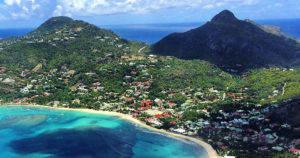While it is not the only “split” island in the Caribbean, St. Martin / St. Maarten is unique in many ways. Unlike the lengthier and decidedly more infamous border that separates Haiti and the Dominican Republic, the dividing line between Dutch St. Maarten and French St. Martin is open, free, and breezy. Indeed, this uncommon border has long been among the most peaceful the world has ever known.
How the Dutch and French finally partitioned the island makes for a great story. Supposedly, the two groups held a contest. Starting at Oysterpond on the east coast, they would walk westwards — the French along the northern edge, the Dutch along the southern — and where they met they would draw a dividing line across the island. The French set off, having fortified themselves with wine, the Dutch with gin. The ill effects of the gin, however, caused the Dutchmen to stop along the way to sleep off their drunk; consequently, the French were able to cover a much greater distance.
Alas in truth, though, the French had a large navy just off shore at the time the treaty was being negotiated, and they were able to win concessions by threat of force. The treaty was signed on top of Mount Concordia in 1648. However, the border was to change another 16 times until 1815 when the Treaty of Paris fixed the boundaries for good.
There are differences between the two islands of course.
- The Dutch side speaks predominantly English, despite the official language being Dutch, while the French side speaks French.
- The Dutch call it Sint Maarten, while the French call it Saint-Martin.
- The Dutch side uses 110 volts, same as the US, whereas the French side uses 220 volts.
- The Dutch side officially uses the Netherlands Antillean Florins (NAF, or Guilders) while the French side uses the Euro. However, on the Dutch side, the US dollar is dominant and the most common currency used. On the French side, the Euro is still dominant.
- Philipsburg is the capital of the Dutch side, while Marigot is the capital of the French side.
- The country code for the Dutch side is 721 (as of October 2011) while the country code for French side is 590. Calling from one side to the other is considered an international phone call.
- Each side has its own international airport, despite the island already being as small as it is.
St. Maarten is probably the only place in the world where France and Netherlands share a border, since they certainly don’t touch each other in Europe! There is still some unity on the island though… They both have nice beaches, island culture, and trade wind, and since so many American tourists come to the island each year, the American dollar is accepted everywhere and English is spoken on both sides. It seems like the tourists are the ones that unify Sint Maarten and Saint Martin!
Special thanks to our friends at Uncommon Caribbean for providing us the inspiration for this blog.












